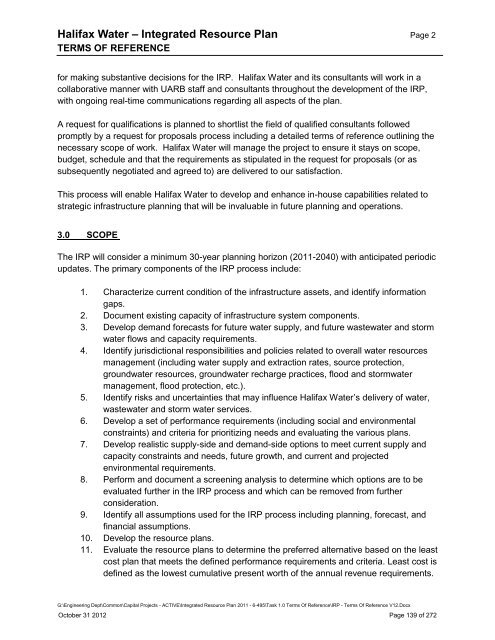volume 1 - Halifax Regional Municipality
volume 1 - Halifax Regional Municipality
volume 1 - Halifax Regional Municipality
You also want an ePaper? Increase the reach of your titles
YUMPU automatically turns print PDFs into web optimized ePapers that Google loves.
<strong>Halifax</strong> Water – Integrated Resource Plan Page 2<br />
TERMS OF REFERENCE<br />
for making substantive decisions for the IRP. <strong>Halifax</strong> Water and its consultants will work in a<br />
collaborative manner with UARB staff and consultants throughout the development of the IRP,<br />
with ongoing real-time communications regarding all aspects of the plan.<br />
A request for qualifications is planned to shortlist the field of qualified consultants followed<br />
promptly by a request for proposals process including a detailed terms of reference outlining the<br />
necessary scope of work. <strong>Halifax</strong> Water will manage the project to ensure it stays on scope,<br />
budget, schedule and that the requirements as stipulated in the request for proposals (or as<br />
subsequently negotiated and agreed to) are delivered to our satisfaction.<br />
This process will enable <strong>Halifax</strong> Water to develop and enhance in-house capabilities related to<br />
strategic infrastructure planning that will be invaluable in future planning and operations.<br />
3.0 SCOPE<br />
The IRP will consider a minimum 30-year planning horizon (2011-2040) with anticipated periodic<br />
updates. The primary components of the IRP process include:<br />
1. Characterize current condition of the infrastructure assets, and identify information<br />
gaps.<br />
2. Document existing capacity of infrastructure system components.<br />
3. Develop demand forecasts for future water supply, and future wastewater and storm<br />
water flows and capacity requirements.<br />
4. Identify jurisdictional responsibilities and policies related to overall water resources<br />
management (including water supply and extraction rates, source protection,<br />
groundwater resources, groundwater recharge practices, flood and stormwater<br />
management, flood protection, etc.).<br />
5. Identify risks and uncertainties that may influence <strong>Halifax</strong> Water’s delivery of water,<br />
wastewater and storm water services.<br />
6. Develop a set of performance requirements (including social and environmental<br />
constraints) and criteria for prioritizing needs and evaluating the various plans.<br />
7. Develop realistic supply-side and demand-side options to meet current supply and<br />
capacity constraints and needs, future growth, and current and projected<br />
environmental requirements.<br />
8. Perform and document a screening analysis to determine which options are to be<br />
evaluated further in the IRP process and which can be removed from further<br />
consideration.<br />
9. Identify all assumptions used for the IRP process including planning, forecast, and<br />
financial assumptions.<br />
10. Develop the resource plans.<br />
11. Evaluate the resource plans to determine the preferred alternative based on the least<br />
cost plan that meets the defined performance requirements and criteria. Least cost is<br />
defined as the lowest cumulative present worth of the annual revenue requirements.<br />
G:\Engineering Dept\Common\Capital Projects - ACTIVE\Integrated Resource Plan 2011 - 6-495\Task 1.0 Terms Of Reference\IRP - Terms Of Reference V12.Docx<br />
October 31 2012 Page 139 of 272
















